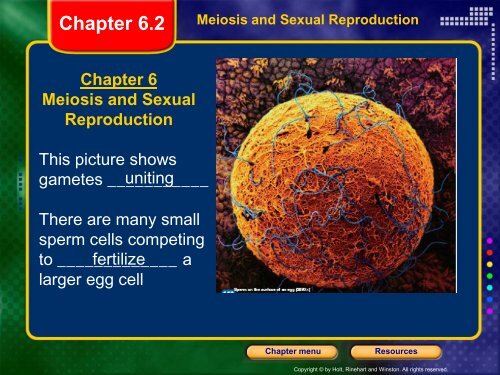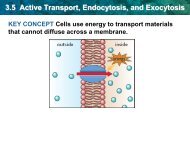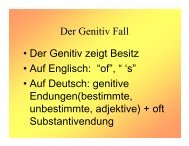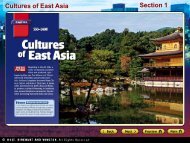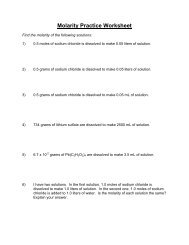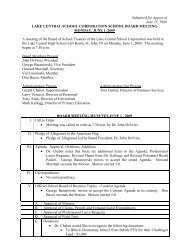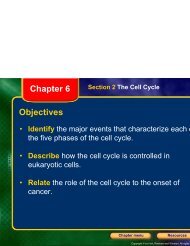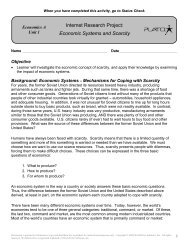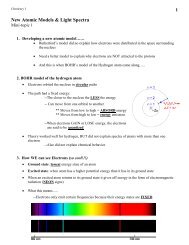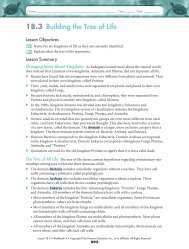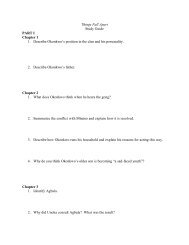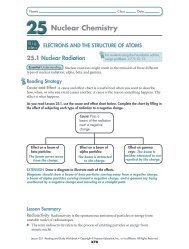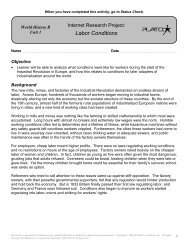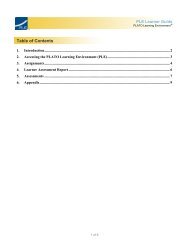Chapter 6.2 Notes
Chapter 6.2 Notes
Chapter 6.2 Notes
You also want an ePaper? Increase the reach of your titles
YUMPU automatically turns print PDFs into web optimized ePapers that Google loves.
<strong>Chapter</strong> <strong>6.2</strong>Meiosis and Sexual Reproduction<strong>Chapter</strong> 6Meiosis and SexualReproductionThis picture showsgametes ___________unitingThere are many smallsperm cells competingto _____________ fertilize alarger egg cell<strong>Chapter</strong> menuResourcesCopyright © by Holt, Rinehart and Winston. All rights reserved.
Section MeiosisObjectives• Summarize the events that occur during meiosis.• Relate crossing-over, independent assortment, andrandom fertilization to genetic variation.• Compare spermatogenesis and oogenesis.<strong>Chapter</strong> menuResourcesCopyright © by Holt, Rinehart and Winston. All rights reserved.
• Meiosis• Crossing over• Independent assortment• Spermatogenesis• Sperm• Oogenesis• ovum<strong>Chapter</strong> menuResourcesCopyright © by Holt, Rinehart and Winston. All rights reserved.
<strong>Chapter</strong> 6Formation of Haploid Cells• Meiosis is a form of cell division that __________ halvesthe number of chromosomes when formingspecialized reproductive cells, such as __________ gametesor _____________spores– These specialized cells are _______________haploids• Since the chromosome number is being______________ reduced by half, this process is often calledcell __________________reduction<strong>Chapter</strong> menuResourcesCopyright © by Holt, Rinehart and Winston. All rights reserved.
• What are the two types of human gametes?Sperm and egg cells• What do gametes do?They fuse to create a fertilized zygote• Why is it important that they contain half the numberof chromosomes as found in a diploid cell?So that they create a diploid cell when theyfuse<strong>Chapter</strong> menuResourcesCopyright © by Holt, Rinehart and Winston. All rights reserved.
• Meiosis involves two divisions of the nucleus called…– _________________Meiosis I– _________________Meiosis II• These divisions are very similar to the process of_________________, mitosisbut with a few changes• Before meiosis begins, the DNA of the original cellmust be copied during _______________interphase– This original cell is a _________________ diploid cell<strong>Chapter</strong> menuResourcesCopyright © by Holt, Rinehart and Winston. All rights reserved.
• Meiosis I includes….– Prophase ___ I– Metaphase ___ I– Anaphase ___ I– Telophase ___ I• Meiosis II includes– Prophase ____ II– Metaphase ____ II– Anaphase ____ II– Telophase ____ II<strong>Chapter</strong> menuResourcesCopyright © by Holt, Rinehart and Winston. All rights reserved.
Prophase I• Nuclear ______________membraneand _______________ nucleolus breakdown• _____________ Spindle is arranged• __________________Chromosomesbecome visible– How many chromosomesare in the cell?4– How many chromatids?8<strong>Chapter</strong> menuResourcesCopyright © by Holt, Rinehart and Winston. All rights reserved.
Prophase I• This stage differs from mitosisbecause the homologouschromosomes ________ pair up ina process called ___________synapsisMeiosisMitosis<strong>Chapter</strong> menuResourcesCopyright © by Holt, Rinehart and Winston. All rights reserved.
• Review...what are homologous chromosomes?– They are a pair of chromosomes that are similar in________________ structure and that also contain genes for thesame ____________– You inherit one from ______ and one from ______– They are not ________________• For example…dad’s chromosome may have a_________ gene while mom’s has a __________ genetalltraitsmomidenticaldadshort<strong>Chapter</strong> menuResourcesCopyright © by Holt, Rinehart and Winston. All rights reserved.
• Since they are not identical,the homologouschromosomes are______________ colored differently• However, the identicalcopies within eachchromosome are coloredthe same…what are theycalled?sister chromatids<strong>Chapter</strong> menuResourcesCopyright © by Holt, Rinehart and Winston. All rights reserved.
• The homologous structures pair up so ____________ tightlythat they form a four part structure called a ________ tetrad• Within a tetrad, a processcalled ________________crossing overmay occur<strong>Chapter</strong> menuResourcesCopyright © by Holt, Rinehart and Winston. All rights reserved.
• During crossing over, areas on _______________nonsisterchromatids may exchange genetic material• This picture showsa ___________ singlecross overLetters = genes<strong>Chapter</strong> menuResourcesCopyright © by Holt, Rinehart and Winston. All rights reserved.
• Before crossing over, how many different genecombinations existed? 2• After crossing over,how many differentgene combinationsexist?4<strong>Chapter</strong> menuResourcesCopyright © by Holt, Rinehart and Winston. All rights reserved.
Metaphase I• The __________ pairs of homologouschromosomes line up along the_______________equator• This arrangement is also_____________ unique to meiosisMeiosisMitosis<strong>Chapter</strong> menuResourcesCopyright © by Holt, Rinehart and Winston. All rights reserved.
Anaphase I• Homologous_______________ chromosomes arepulled apart by spindlefibers and movedtowards______________ opposite polesof the cell<strong>Chapter</strong> menuResourcesCopyright © by Holt, Rinehart and Winston. All rights reserved.
Telophase I and CytokinesisProphase I• Opposite of ______________• Cytokinesis splits the__________________ cytoplasm andseparates the ______ 2 new cells• How many chromosomes are ineach new cell?• The chromosome number has beenreduced by _______ half and the cellsare now _____________2haploid<strong>Chapter</strong> menuResourcesCopyright © by Holt, Rinehart and Winston. All rights reserved.
After Meiosis IAfter Mitosis4 chromosomes per cell2 chromosomes per cell<strong>Chapter</strong> menuResourcesCopyright © by Holt, Rinehart and Winston. All rights reserved.
VERY IMPORTANT!!!!!!!!• These two cells do NOT enter ________________interphaseagain and do NOT copy their ________ DNA again!• They both proceed with meiosis ____. II<strong>Chapter</strong> menuResourcesCopyright © by Holt, Rinehart and Winston. All rights reserved.
Metaphase II• Now, _______________individualchromosomes line upalong the equator ineach cell<strong>Chapter</strong> menuResourcesCopyright © by Holt, Rinehart and Winston. All rights reserved.
Anaphase II• Sister _____________chromatidsare pulled towards theopposite poles of eachcell• After the chromatidsseparate, what are theycalled?chromosomes<strong>Chapter</strong> menuResourcesCopyright © by Holt, Rinehart and Winston. All rights reserved.
Telophase II and Cytokinesis• In each cell, the nuclearmembrane andnucleolus ___________ reform• The spindle______________dissolves• Chromosomes will____________uncoil• Cytokinesis splits thecells into ______ 4 uniquehaploid cells<strong>Chapter</strong> menuResourcesCopyright © by Holt, Rinehart and Winston. All rights reserved.
Meiosis and Genetic Variation• Meiosis is an important process that allows for therapid generation of new genetic ________________.combinations• Three mechanisms make key contributions to thisgenetic variation:– _________________________Independent Assortment– _________________________Random fertilization– _________________________Crossing over<strong>Chapter</strong> menuResourcesCopyright © by Holt, Rinehart and Winston. All rights reserved.
Independent Assortment• Refers to the _____________ random distribution ofhomologous chromosomes during meoisis I<strong>Chapter</strong> menuResourcesCopyright © by Holt, Rinehart and Winston. All rights reserved.
• In ____________________, Metaphase I the homologous chromosomesmay pair and line up randomly on either side<strong>Chapter</strong> menuResourcesCopyright © by Holt, Rinehart and Winston. All rights reserved.
segregategametes• This affects how the chromosomes ________________and are passed along to the ________________<strong>Chapter</strong> menuResourcesCopyright © by Holt, Rinehart and Winston. All rights reserved.
• Since humans have 23 pairs of homologouschromosomes…each pair has ____ 2 ways it may facewhile lining up• Mathematically, the total number of possible gametesformed is…2 n or 2 23 = 8,388,608 gametes<strong>Chapter</strong> menuResourcesCopyright © by Holt, Rinehart and Winston. All rights reserved.
Random fertilizationfuse• Each of the possible gametes (2 23 ) must _______ withanother one of the possible gametes (2 23 ) duringfertilization– Mathematically, the total number of possible zygotesis…2 23 x 2 23 = 70,368,744,000,000 zygotes• So many different ________________ with great_________________ may resultvariationoffspring<strong>Chapter</strong> menuResourcesCopyright © by Holt, Rinehart and Winston. All rights reserved.
Crossing over• Since homologous chromosomes may __________ exchangegenetic information within a tetrad, the number ofpossible gametes and zygotes is actually___________________unlimited<strong>Chapter</strong> menuResourcesCopyright © by Holt, Rinehart and Winston. All rights reserved.
Importance of Genetic Variation• Meiosis and the joining of gametes are essential to__________________evolution• The pace of evolution is sped up by genetic_______________.recombination– Each offspring contains a combination of genesthat is ________________ different from each parent<strong>Chapter</strong> menuResourcesCopyright © by Holt, Rinehart and Winston. All rights reserved.
Gamete Formation in Males and FemalesMeiosis in Males• The process by which sperm are produced in maleanimals is called _______________________spermatogenesis• Spermatogenesis occurs in the male reproductiveorgan, called the _______________testes<strong>Chapter</strong> menuResourcesCopyright © by Holt, Rinehart and Winston. All rights reserved.
• First, an immaturediploid cell, calleda ___________ germcell, begins togrow• After meiosis, four_____________uniquehaploid cells areformed<strong>Chapter</strong> menuResourcesCopyright © by Holt, Rinehart and Winston. All rights reserved.
• These haploidcells must______________,differentiatemeaning theymust changeslightly in formand develop_________, flagella tobecome spermcells<strong>Chapter</strong> menuResourcesCopyright © by Holt, Rinehart and Winston. All rights reserved.
Meiosis in Females• The process by which gametes are produced infemale animals is called ____________________oogenesis• Oogenesis occurs in the female reproductive organs,called _______________ ovaries and produces femalegametes called eggs or ________ ova (ovum –singular)<strong>Chapter</strong> menuResourcesCopyright © by Holt, Rinehart and Winston. All rights reserved.
• In oogenesis, thecytoplasm does notdivide ____________, equallyresulting in…one– _____ large eggcell that containsmore cytoplasm and______________nutrients3– and ______ smallercells called second_________ polar___________, bodieswhich will all die<strong>Chapter</strong> menuResourcesCopyright © by Holt, Rinehart and Winston. All rights reserved.
Objective 1• Summarize the events that occur during meiosis.At the beginning of Meiosis I, homologous chromosomes________ pair tightly to form ___________ tetrads in a process called_____________. synapsis ____________ Crossing over may occur. Whenthe homologous chromosomes separate, two____________ cells are formedhaploidchromatidsDuring Meiosis II, the sister ______________ separate,forming _____ 4 different gametes.<strong>Chapter</strong> menuResourcesCopyright © by Holt, Rinehart and Winston. All rights reserved.
Objective 2• Relate crossing-over, independent assortment, andrandom fertilization to genetic variation.Crossing over –Changes gene combinations onchromosomesIndependent Assortment –The homologous chromosomes line up andsegregate randomly during Meiosis I.Random fertilization -The possible gametes fuse randomly<strong>Chapter</strong> menuResourcesCopyright © by Holt, Rinehart and Winston. All rights reserved.
Objective 3• Compare spermatogenesis and oogenesis.Creates four motilesperm cellsCreates one large eggcell and three smallerpolar bodies<strong>Chapter</strong> menuResourcesCopyright © by Holt, Rinehart and Winston. All rights reserved.


